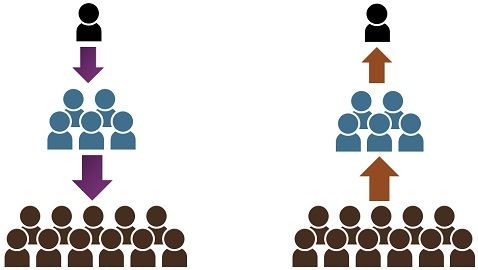 Upward communication refers to that form of communication that flows from bottom to top. On the other extreme, downward communication is the communication, which moves from top to bottom. Communication is the spine of an organisation because without it superior-subordinate relationship cannot thrive and the organisation will not be able to function effectively, to achieve the objectives. It pertains to the meaningful and effective interaction between two or more people.
Upward communication refers to that form of communication that flows from bottom to top. On the other extreme, downward communication is the communication, which moves from top to bottom. Communication is the spine of an organisation because without it superior-subordinate relationship cannot thrive and the organisation will not be able to function effectively, to achieve the objectives. It pertains to the meaningful and effective interaction between two or more people.
There are two channels of communication, namely formal communication and informal communication. Further, there are three directions in which formal communication flows, i.e. vertical, horizontal and diagonal. Vertical communication can take place in two ways – Upward Communication and Downward Communication.
Now, let’s take a look at the article, which describes the difference between upward and downward communication.
Content: Upward Communication Vs Downward Communication
Comparison Chart
| Basis for Comparison | Upward Communication | Downward Communication |
|---|---|---|
| Meaning | Upward communication is the line of communication through which subordinates can convey information, to their seniors. | Downward communication is the formal chain of command established to direct subordinates and convey information, pertaining to organization's objectives, policies and strategies. |
| Nature | Participative and Appealative | Authoritative and Directive |
| Flow | Subordinate to superior. | Superior to subordinate. |
| Purpose | To make complaints or appeal, give feedback and suggestions | To give orders, instructions, advice or assign responsibilities. |
| Speed | Slow | Fast |
| Frequency | Low | Comparatively high |
| Examples | Reports, direct letters and proposals | Circulars and Notices |
Definition of Upward Communication
When the flow of information in an organisation, is from lower levels of the corporate ladder to the upper levels, is named as upward communication. This form of communication, helps employees, to express their views, ideas or grievances with the top management. It is possible only in a democratic environment, wherein employees have a say in management.
Upward communication flows from subordinate to superior, which helps in the increase in acceptance of management decision by the subordinates. However, it suffers from various limitations like the long chain of command, lack of confidence in superiors, fear of criticism, lack of common sharing, etc.
In this type of communication, the message can be transmitted either through oral media – employer-employee meeting, grievance procedure, open door policy, etc. and written media – reports, letters, complaints, suggestions, etc.
Definition of Downward Communication
Downward communication can be defined as a transmission of information and messages from the top level executives to the low-level employees. This means that the communication is initiated by the highest level of management in the corporate ladder, to convey orders, instructions, warnings or responsibilities to the subordinates working in the organisation.
Downward communication is helpful for the managers in informing the employees, the vision, mission, goals, objectives, policies and procedures of the organisation. It can take the form of oral communication – as face-to-face conversation, meetings, speeches, conferences, etc. and written communication – handbook, notices, circulars, digital news display, warnings and so forth.
This type of communication suffers from various shortcomings like filtration of message, misunderstanding and confusion, the reliability of the source, distortion of the message, unclear message, message overload, etc.
Key Differences Between Upward and Downward Communication
The difference between upward and downward communication can be drawn clearly on the following grounds:
- The type of communication which is initiated by the lower level employees, to convey their message or information to the upper-level management of the organisational hierarchy is known as upward communication. Conversely, when the transmission of information takes place through the organisation’s formal chain of command, then the communication is known as downward communication.
- The nature of upward communication is participative one, which invites subordinates to share their views and opinions with the top management. On the other end, the downward communication is authoritative in nature that tends to direct subordinates regarding the mission and goals of the company.
- Upward communication is used to make complaints or appeal, give feedback, opinions and suggestions. Unlike, downward communication, which is used to give orders, commands, warnings, advice or assign responsibilities.
- Upward communication is more time consuming than the downward communication, as the latter is empowered by authority and is time bounded.
- The occurrence of upward communication is occasional, while the occurrence of downward communication is frequent.
- The common forms of upward communication are reports, direct letters and proposals. On the contrary, the common forms of downward communication are orders, circulars and notices.
Conclusion
Both the types of communication are the two aspects of vertical communication and are complementary to one another. The success of downward communication can be ascertained by upward communication, i.e. it evaluates the effectiveness of policies, plans and strategies executed by the top-level management, through the response of those working at the lower levels of the organisational echelon.






fodrey says
This was really helpful, so logical. Really makes sense and is in chronological order, Excellent.
Austin Zinyowera says
That’s helpful and logic
Philip Obuekezie says
This helps a lot.
zidane says
very clear and good article easy to understand. Thank you
Vaishnavi J. says
Thank you for sharing:)
Vikash Kumar says
Such a great article. Reading the article from beginning to end was so enlightening. I’m so glad this came up. Knowledge is power.
Chetumalile Alabi says
this was helpful